TOP 30 mysteries of nature, in which magic definitely intervened
04 Jan 2022At first glance, these places and living organisms may appear to be drawn by some very talented artist! But they exist in reality. We are convinced that there is no magic here!
1. Pink dolphins
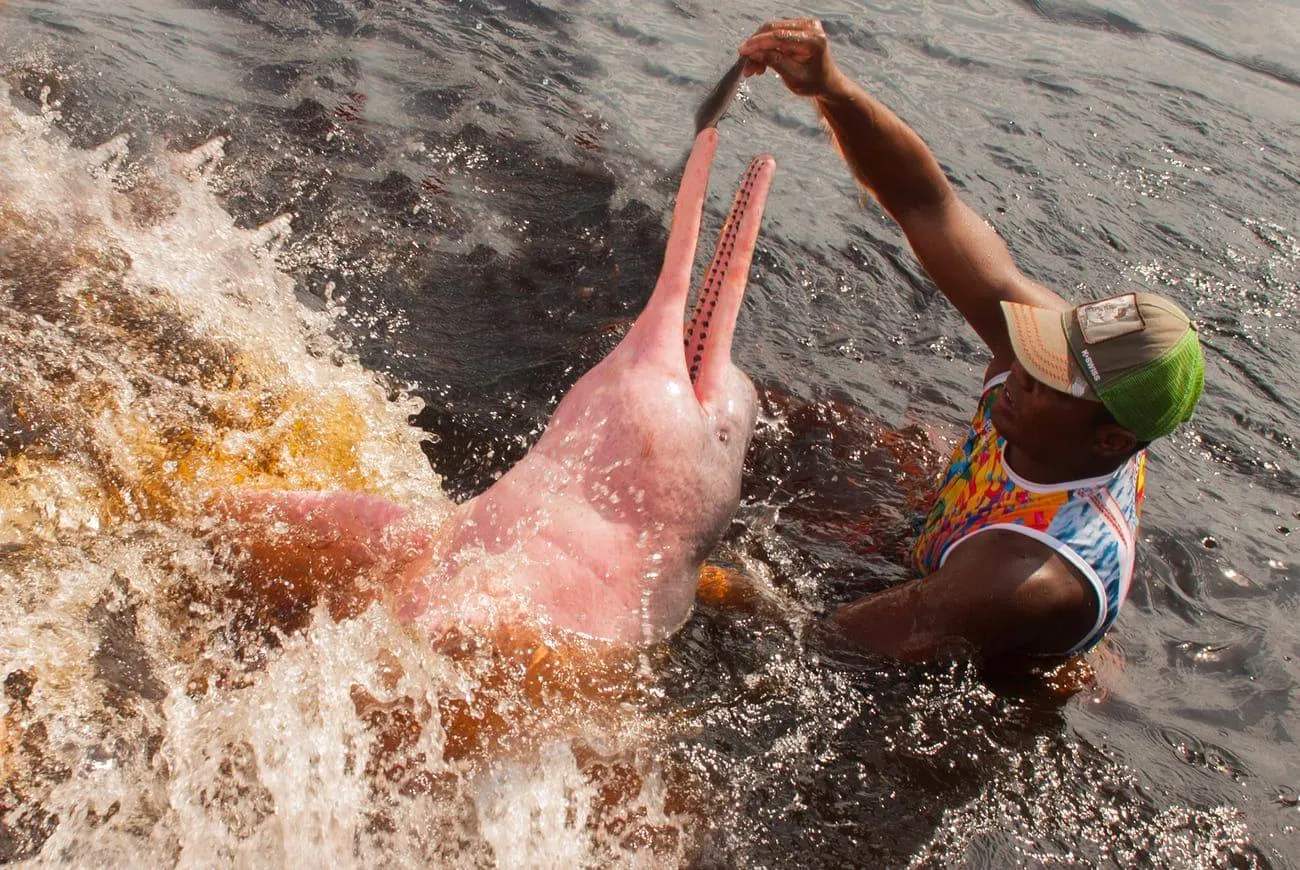
Pink dolphins are a true mystery of nature. They are also called "Amazon dolphins" or "inias" and they live in the Amazon River, in the caves of the Orinoco River and some higher reaches of the Madeira River. Although these dolphins are pink in color, they are born gray and gradually turn pink as they age. An interesting fact is that when dolphins are excited, they can blush. Pink dolphins are called one of the most endangered species among all cetaceans in the world.
2. Red waterfall
The scariest waterfall on the planet is located in the eastern part of Antarctica, in the McMurdo Strait area. It was discovered in 1911 by the Australian traveler and geologist Griffith Taylor. He suggested that it was due to algae, tiny microorganisms that have a red color. In his opinion, they could be preserved in the glacier and dye the water bright red when melting.
However, later American scientists led by microbiologist Jill Mikucki found out that rust, not algae, was to blame.
3. "Dragon's Eye" lake, Japan
The lake completely hides under snow and ice in winter. In May, the snow begins to melt, and the reservoir becomes like a real "dragon's eye". The eye of a giant dragon appears on the surface of a 50-meter lake because the snow melts much more intensively near the shore and in the central part of the reservoir.
You can visit Kagami Numa from the end of May to the beginning of June when the dragon's eye phenomenon lasts.
4. Pink snow

Strange pink spots sometimes appear on the snow in alpine regions at an altitude of about 3.5 kilometers above sea level. Such a miracle of nature can be seen in the Sierra Nevada mountains in California or Greenland, the Caucasus mountains, or the Northern Urals. This phenomenon can usually be observed in the mountains in summer and spring when the temperature is slightly above freezing, but still low enough for the snow to melt completely.
If you see this snow, you might be surprised to find that it smells like watermelon! It's all about algae. Chlamydomonas nivalis is the name of the algae that gives snow its watermelon color and characteristic smell. Its main feature is the possibility of existence at low temperatures.
5. Diamond Beach, Iceland
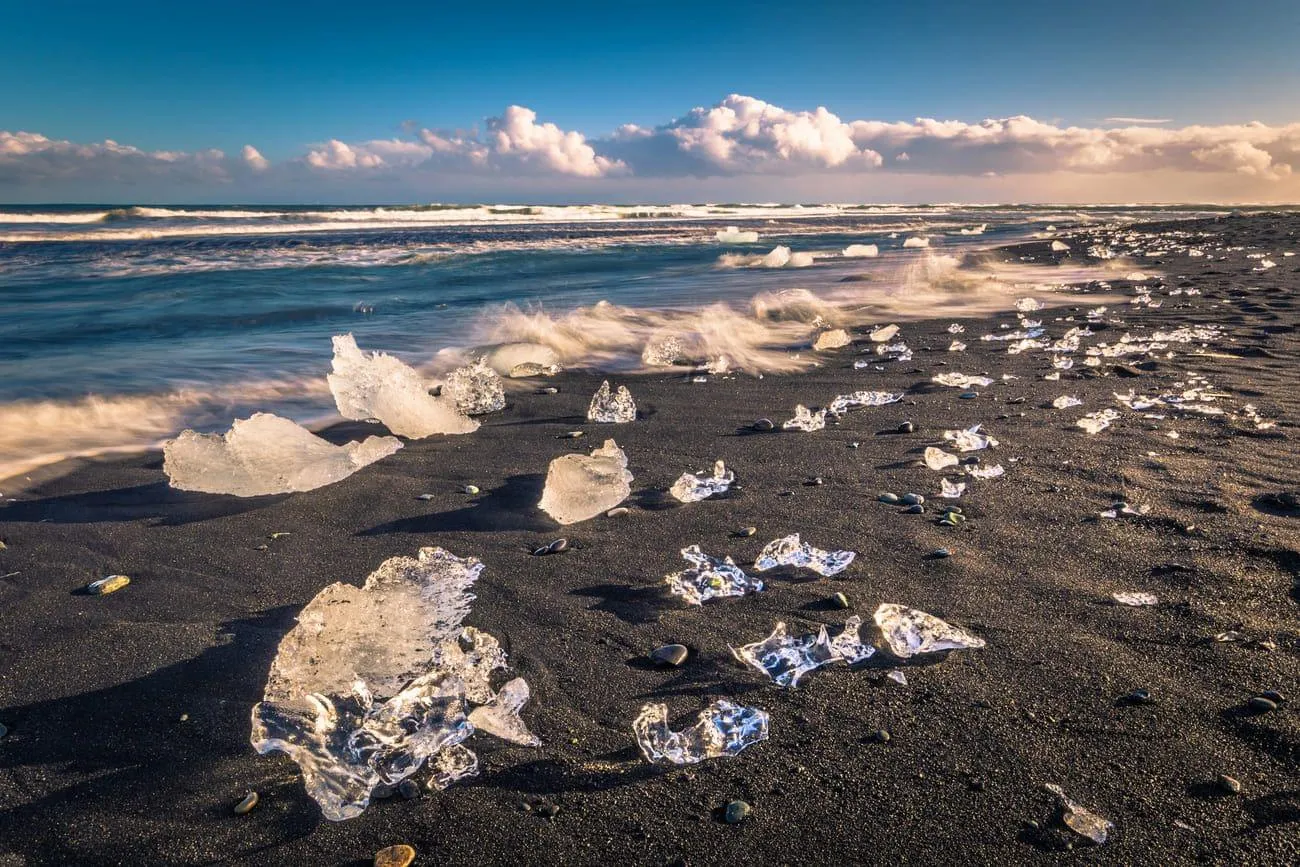
It's located next to the Jokulsarlon Glacial Lagoon on the south coast of Iceland, about six hours from the country's capital, Reykjavik. The lagoon is filled with huge pieces of ice that constantly fall off the glacier. Due to global warming, glacier is melting at a tremendous speed, and huge blocks of ice are breaking off. Once in the sea, they turn into icebergs, but the smaller “pieces” are picked up by waves and thrown ashore. During the day, ice fragments are similar to large diamonds in the rays of light. The size of these "diamonds" can vary from the size of a palm to the larger of a person. The same with the color - it varies from deep blue to bright white!
6. Glass frog
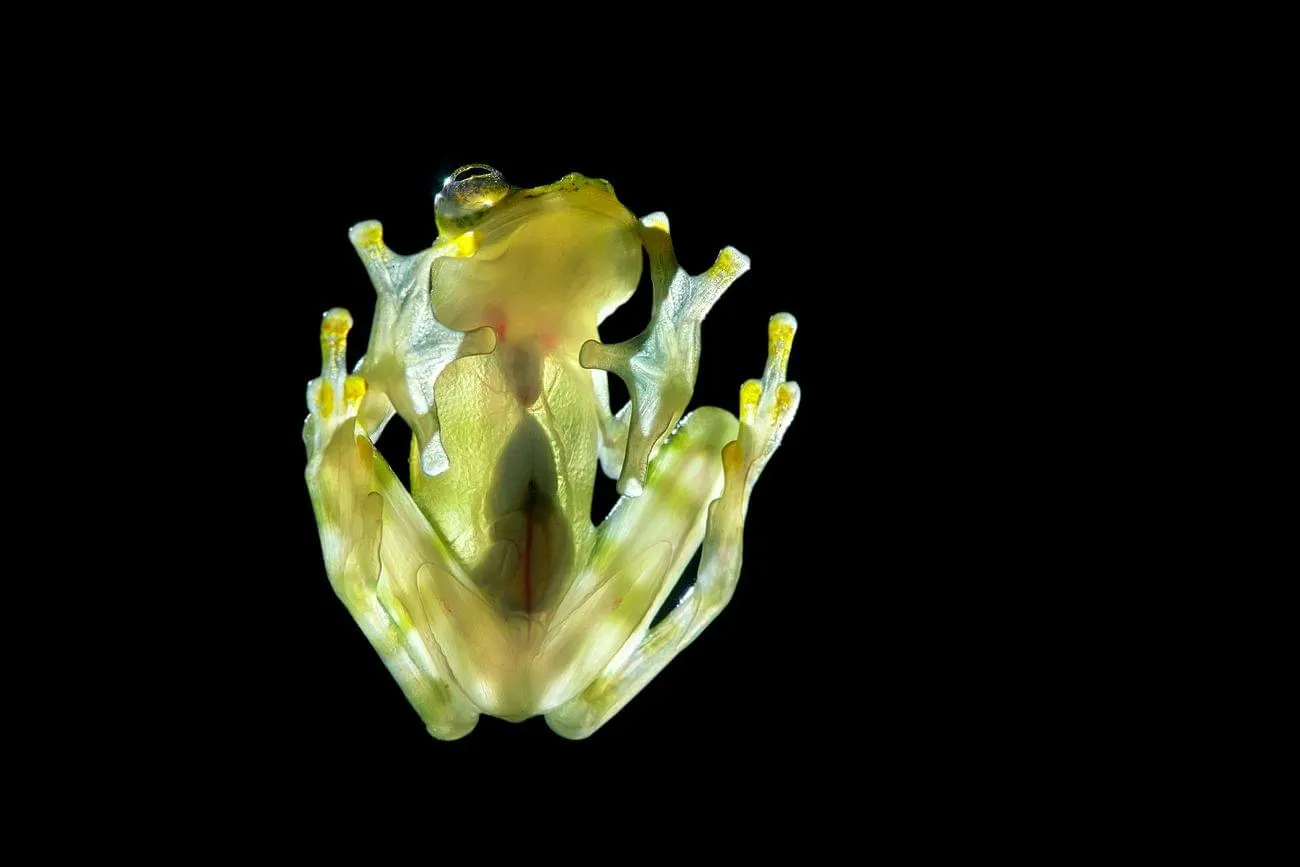
The existence of these frogs was first learned in 1872. In this year, Europeans discovered these animals in Ecuador, but usually they can be found in the northwestern part of South America, Central America and a number of other areas of South America.
Glass frogs are traditionally green in color, but they have almost completely transparent abdominal skin, through which the organs inside can be seen. You can watch the glass frog's heart pump blood throughout its body. Glass frogs are usually not very large, from 3 to 7.5 centimeters.
7. The Red River in Spain
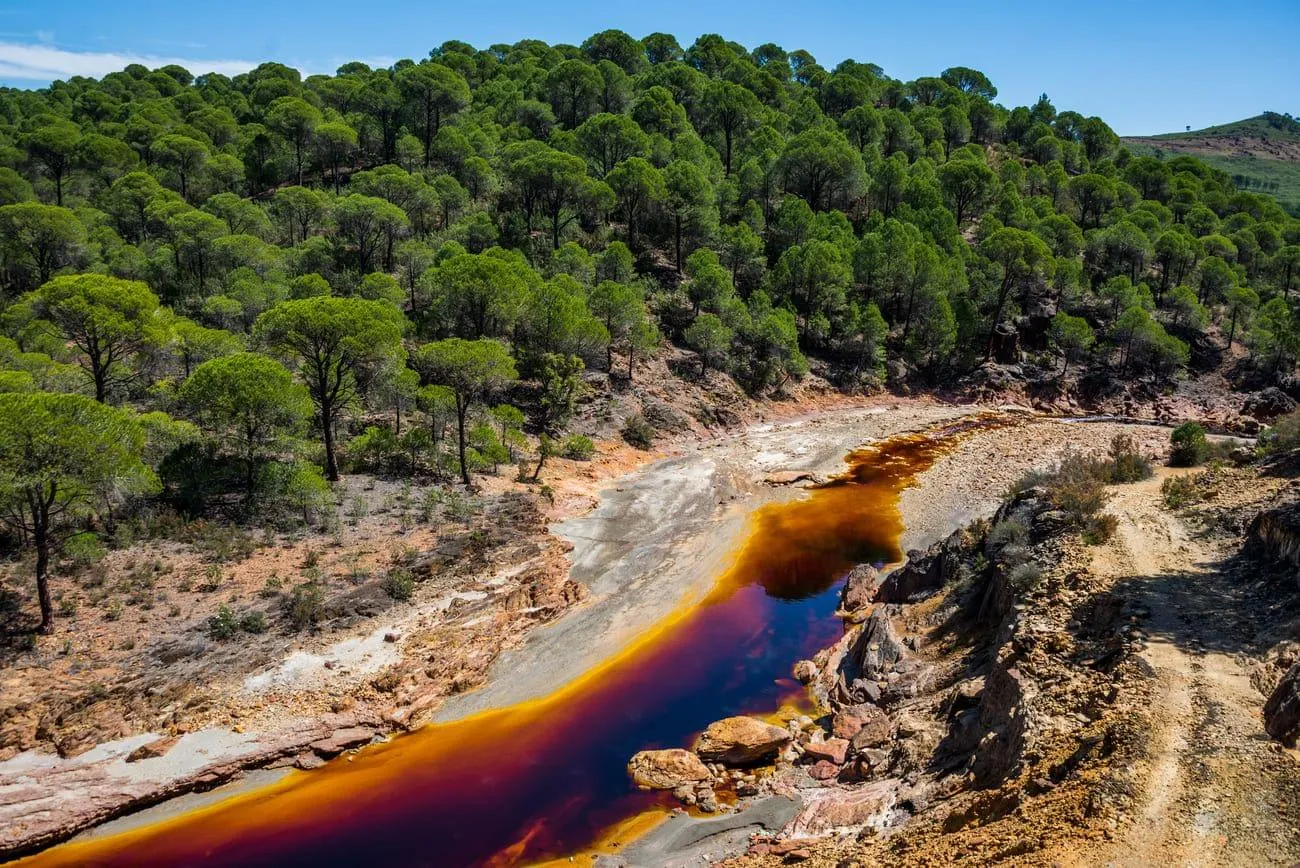
The water in this river is red, like blood. The river maintains its color for an approximate length of 50 kilometers. Five thousand years before our era, the local inhabitants - Iberians and Tartessians, and later Carthaginians - mined iron ore, gold, silver, and copper, which lay quite close to the surface, on the banks of the Rio Tinto River. Mining over a long period caused irreparable damage to the river: the soils oxidized, the water began to acquire a rich red hue, and the level of acidity of the Rio Tinto inevitably increased. The water of River Tinto is very toxic, so fish or other living organisms can’t live there! Today, the river is inhabited only by colonies of bacteria.
8. Blue lava
On the island of Java, there is a volcano called Kawah Ijen, which erupts extremely rarely, but every time it is an extraordinary event. After all, a real phenomenon is happening, the volcano is spewing blue lava! Such a bright blue color is the result of a number of chemical reactions. When a volcano erupts, its lava turns iridescent blue. Also, this lava is different from others that come out of most stratovolcanoes: it is a rather viscous, slowly moving consistency that reaches a temperature of 600-900 ° C.
If you want to visit this natural wonder, be careful. Sulfuric gases, extremely harmful to the respiratory system. Therefore, you cannot do without a gas mask.
9. A tree in the Dead Sea
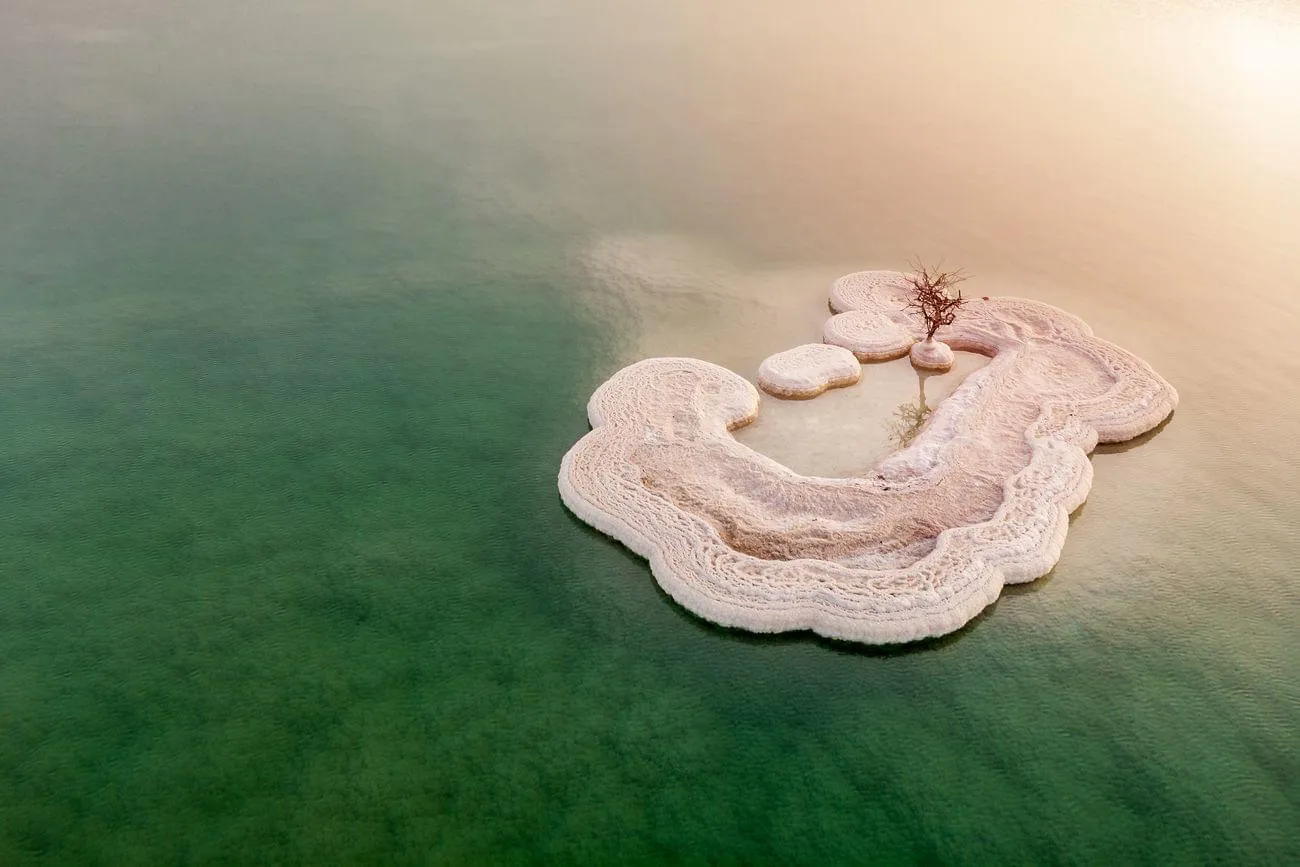
The Dead Sea is at a depth of 400 meters below the ocean and is considered the lowest point on the planet. Everyone knows that he is called "dead" for a reason. After all, there are no algae, fish, or insects here. Therefore, the tree around the salt island seems a surreal phenomenon. But as it turned out, there is an explanation for this. A local rescuer planted the tree and takes care of it every day. He called his masterpiece "Dead tree in the sea of life". Every day he swims up to it and covers it with useful substances.
10. Goblin shark
The goblin shark lives at a depth of more than 300 meters and never rises to the surface. The bones and teeth of these animals, about 80 million years old, confirm the ancient origin of the species, which, by the way, was considered extinct in the Cretaceous period. And even though the first living member of the Scapanorhynch family was caught more than a century ago, there is still little information about these monsters. It is only known that these dangerous creatures are extremely rare, although they are found in the waters of absolutely all oceans.
11. Pink Lake Natron
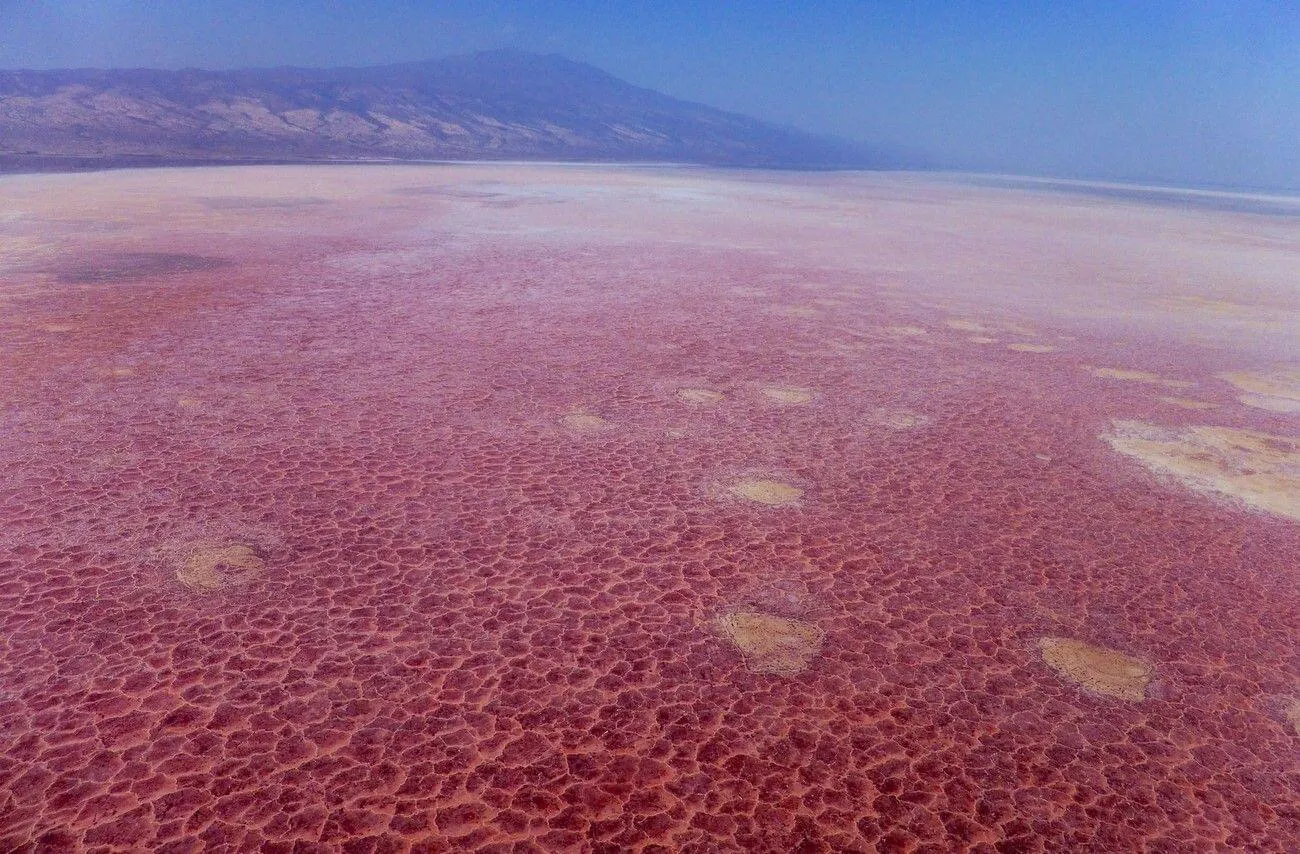 The lake is located in the north of Tanzania and is covered with a crust of salt. But what's surprising is that it can change color over the course of a year. As a result of the vital activity of microorganisms - halophilic cyanobacteria living in Natron, the water can become red or pink. And this happens several times a year when the temperature rises, when bacteria release a red pigment that colors the lake.
The lake is located in the north of Tanzania and is covered with a crust of salt. But what's surprising is that it can change color over the course of a year. As a result of the vital activity of microorganisms - halophilic cyanobacteria living in Natron, the water can become red or pink. And this happens several times a year when the temperature rises, when bacteria release a red pigment that colors the lake.
The concentration of salt and alkali in Lake Natron is so strong that animals and birds that accidentally fall into the water die and are mummified. The exception is small flamingos: ideal breeding conditions for these birds are created here. The high water temperature, reaching 50°C in wetlands, allows flamingos to incubate eggs at any time of the year.
12. Blue mushrooms
Lactarius indigo is an edible species of lamellar mushrooms of the genus Lactarius of the Russulaceae family. In nature, it is found in deciduous and coniferous forests, forming mycorrhizal connections with a wide range of trees. Common throughout South and Eastern North America, but more common along the Gulf Coast.
It can also be found in China and India, where it grows in forests dominated by oak. But in Europe, it was found only in the south of France.
13. Multicolored mountains
 Zhangye Danxia Landform - as these mountains are correctly called - a geological park in the northwestern part of China. The legendary Silk Road once passed here, but today thousands of tourists come to admire the colorful mountains. The unusual color of the rock is the result of the interaction of red sandstone and sedimentary rocks for more than 24 million years. The resulting "layers" were bent by tectonic plates, the same ones responsible for the formation of the Himalayas. The wind and rain finished the job, creating mountain formations of strange whimsical shapes - pillars, towers, ravines, valleys and stone waterfalls, all of different colors, shapes and sizes.
Zhangye Danxia Landform - as these mountains are correctly called - a geological park in the northwestern part of China. The legendary Silk Road once passed here, but today thousands of tourists come to admire the colorful mountains. The unusual color of the rock is the result of the interaction of red sandstone and sedimentary rocks for more than 24 million years. The resulting "layers" were bent by tectonic plates, the same ones responsible for the formation of the Himalayas. The wind and rain finished the job, creating mountain formations of strange whimsical shapes - pillars, towers, ravines, valleys and stone waterfalls, all of different colors, shapes and sizes.
14. "Black Sun" in Denmark
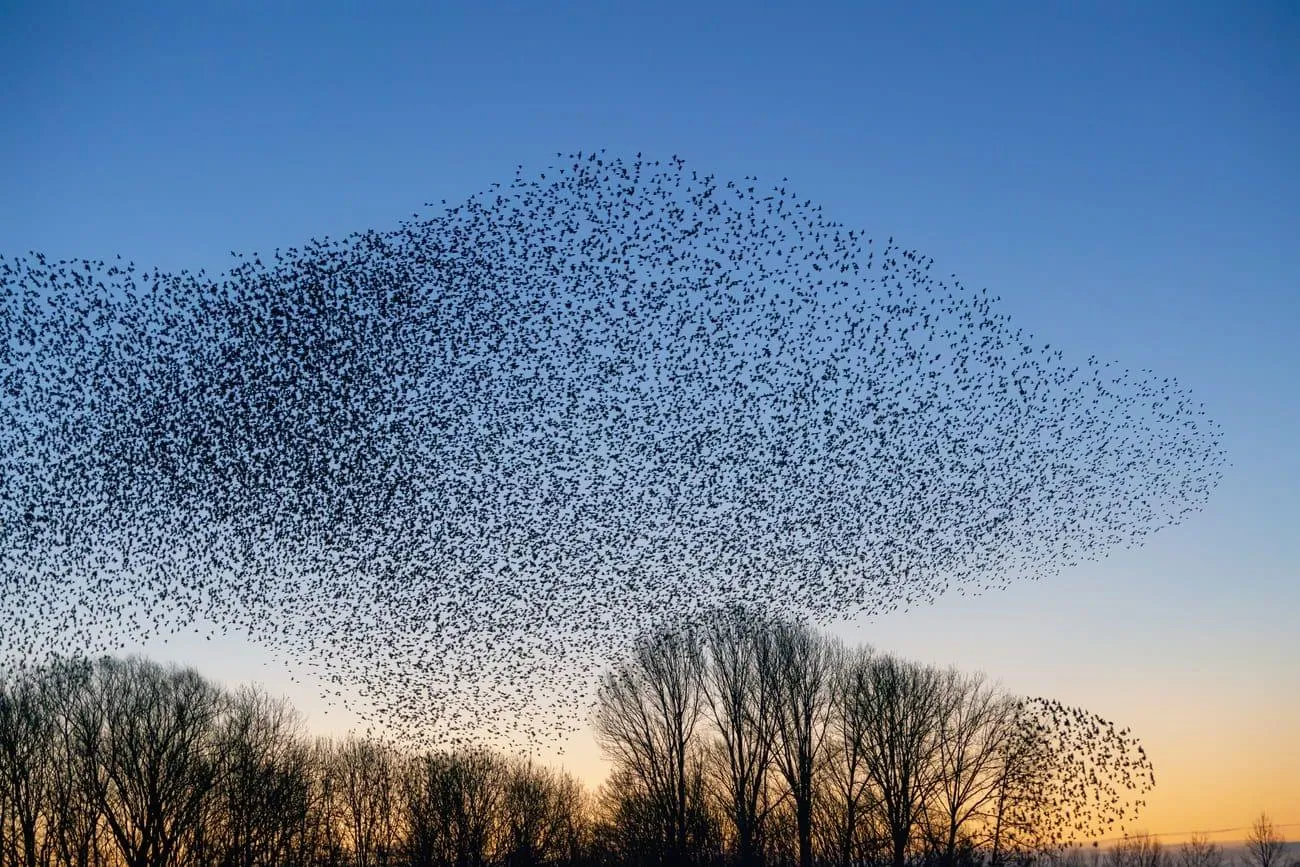 In the period from March to mid-April in Denmark, you can observe an amazing phenomenon: more than a million European starlings (sturnus vulgaris) fly from all around in huge flocks about an hour before sunset. This was given the name "Black Sun", because the birds form giant clouds of various shapes in the air and practically cover the sun. Starlings migrate from the south and spend the day in the meadows, gathering food, and by evening, after making collective pirouettes in the sky, settle down for the night to rest in the reeds. The spectacle becomes especially impressive when birds of prey appear "on stage" to hunt starlings. The spectacle becomes especially impressive when birds of prey appear "on stage" to hunt starlings. Predators scare them, and a huge flock becomes agitated, constantly changing its form.
In the period from March to mid-April in Denmark, you can observe an amazing phenomenon: more than a million European starlings (sturnus vulgaris) fly from all around in huge flocks about an hour before sunset. This was given the name "Black Sun", because the birds form giant clouds of various shapes in the air and practically cover the sun. Starlings migrate from the south and spend the day in the meadows, gathering food, and by evening, after making collective pirouettes in the sky, settle down for the night to rest in the reeds. The spectacle becomes especially impressive when birds of prey appear "on stage" to hunt starlings. The spectacle becomes especially impressive when birds of prey appear "on stage" to hunt starlings. Predators scare them, and a huge flock becomes agitated, constantly changing its form.
15. Underwater waterfall
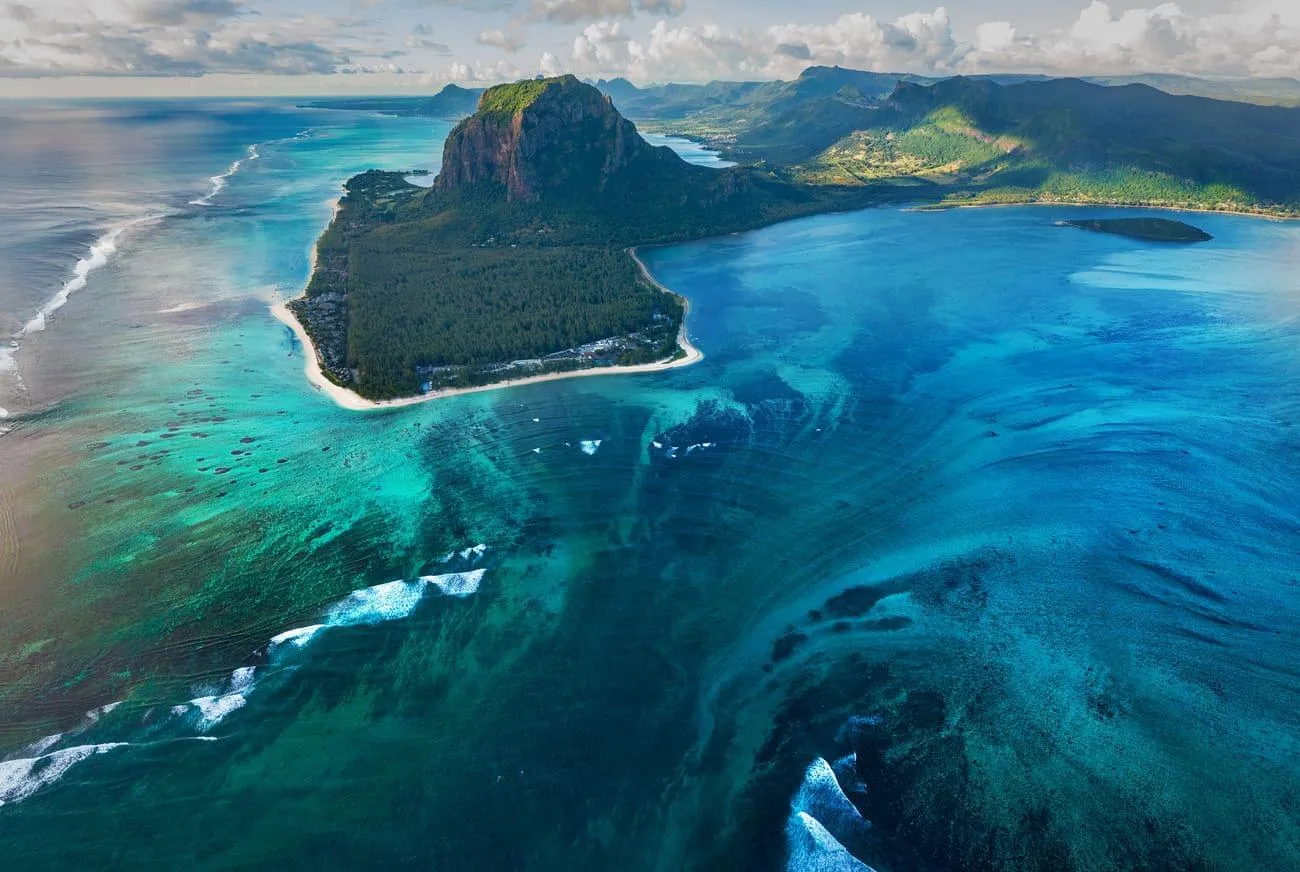 The unique underwater waterfall is located a few hundred meters from the southwest coast of the island of Mauritius, opposite the Le Morne Brabant peninsula. This is an optical illusion that arose due to the bizarre landscapes of the ocean floor near the island, strong underwater currents, sand washes and silt deposits.
The unique underwater waterfall is located a few hundred meters from the southwest coast of the island of Mauritius, opposite the Le Morne Brabant peninsula. This is an optical illusion that arose due to the bizarre landscapes of the ocean floor near the island, strong underwater currents, sand washes and silt deposits.
The depth of the coastal waters of Mauritius is from 8 to 150 meters, but there are places where it reaches several hundred meters. It is in such a place that the illusion of an underwater waterfall arises.
16. Mantis shrimp
 Mantis shrimp is not just a beautiful colorful crustacean, but also a very strong stomach. Which has the fastest impact on the seabed. Mantis shrimp Odontodactylus scyllarus use a pair of legs covered with sharp spines to strike. The limbs of the crustacean, which does not exceed 30 centimeters in length, almost instantly develop a speed of up to 80 kilometers per hour. This is 50 times faster than the blink of an eye. The impact force is about one and a half thousand newtons, which makes it possible to break the hard shells of molluscs easily, like an egg shell.
Mantis shrimp is not just a beautiful colorful crustacean, but also a very strong stomach. Which has the fastest impact on the seabed. Mantis shrimp Odontodactylus scyllarus use a pair of legs covered with sharp spines to strike. The limbs of the crustacean, which does not exceed 30 centimeters in length, almost instantly develop a speed of up to 80 kilometers per hour. This is 50 times faster than the blink of an eye. The impact force is about one and a half thousand newtons, which makes it possible to break the hard shells of molluscs easily, like an egg shell.
17. Big blue hole
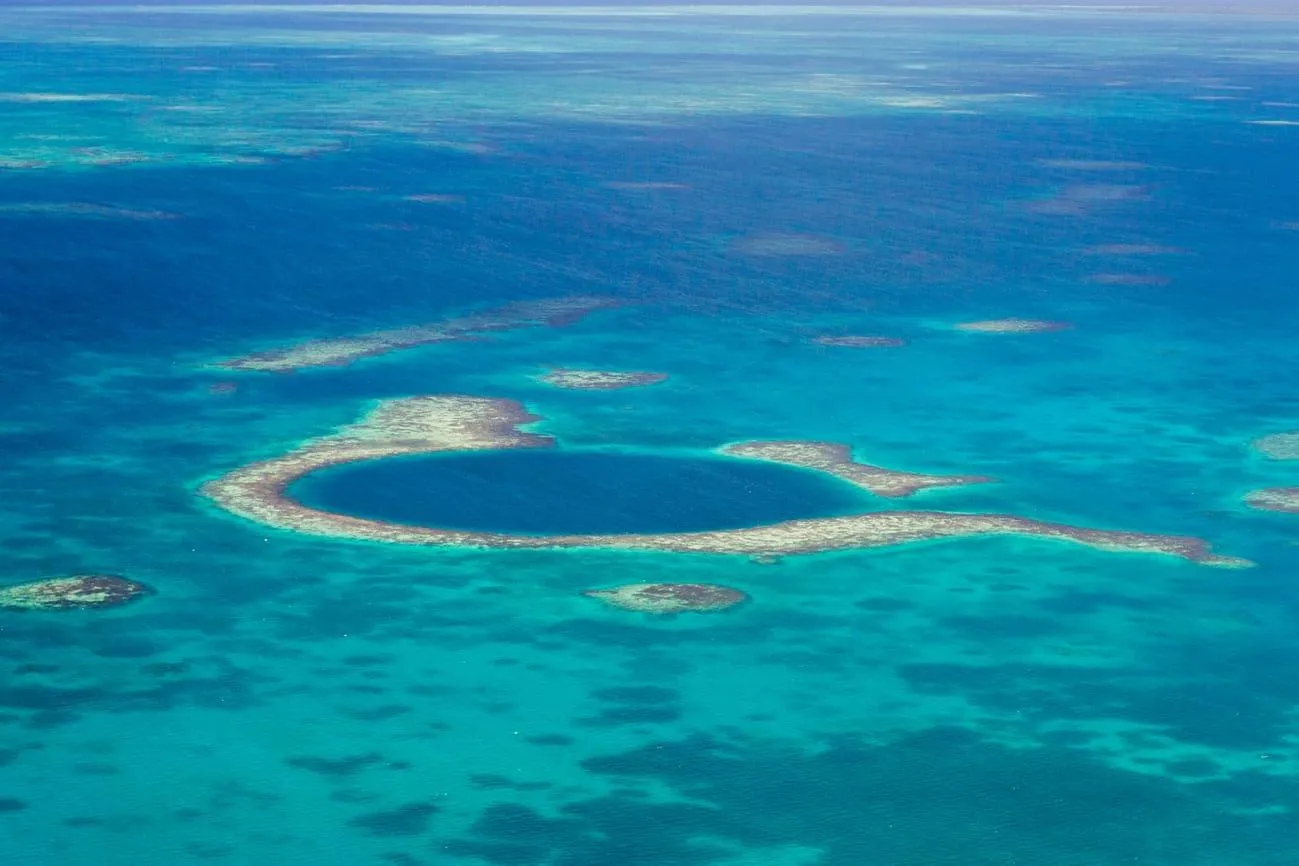 The Great Blue Hole is located in the center of Lighthouse Reef, an atoll within the Belize Barrier Reef. Its diameter is 305 meters, its depth is 120 meters and it is actually perfectly round! It was once a system of limestone caves formed during the last ice age. But when the ocean rose and the ceiling of the flooded cave collapsed and such a "hole" was formed.
The Great Blue Hole is located in the center of Lighthouse Reef, an atoll within the Belize Barrier Reef. Its diameter is 305 meters, its depth is 120 meters and it is actually perfectly round! It was once a system of limestone caves formed during the last ice age. But when the ocean rose and the ceiling of the flooded cave collapsed and such a "hole" was formed.
It became famous in 1972 thanks to the French researcher Jacques-Yves Cousteau, who included it in the list of the 10 best places in the world for diving.
18. Rainbow eucalyptus
 This tree kept its name due to its unusual bark and its properties. At different times of the year, this eucalyptus loses pieces of bark, leaving behind a bright green layer that darkens over time and can have such shades as blue, purple, and even red and orange. The rainbow eucalyptus is native to the tropical rainforests of New Britain, New Guinea, Sulawesi, Mindanao and Seram. However, currently it can be found in the forests, parks and botanical gardens of Brazil, Congo, Costa Rica, Cuba, Hawaii, Fiji, Samoa, Taiwan, the southern provinces of China, etc.
This tree kept its name due to its unusual bark and its properties. At different times of the year, this eucalyptus loses pieces of bark, leaving behind a bright green layer that darkens over time and can have such shades as blue, purple, and even red and orange. The rainbow eucalyptus is native to the tropical rainforests of New Britain, New Guinea, Sulawesi, Mindanao and Seram. However, currently it can be found in the forests, parks and botanical gardens of Brazil, Congo, Costa Rica, Cuba, Hawaii, Fiji, Samoa, Taiwan, the southern provinces of China, etc.
19. Monkfish
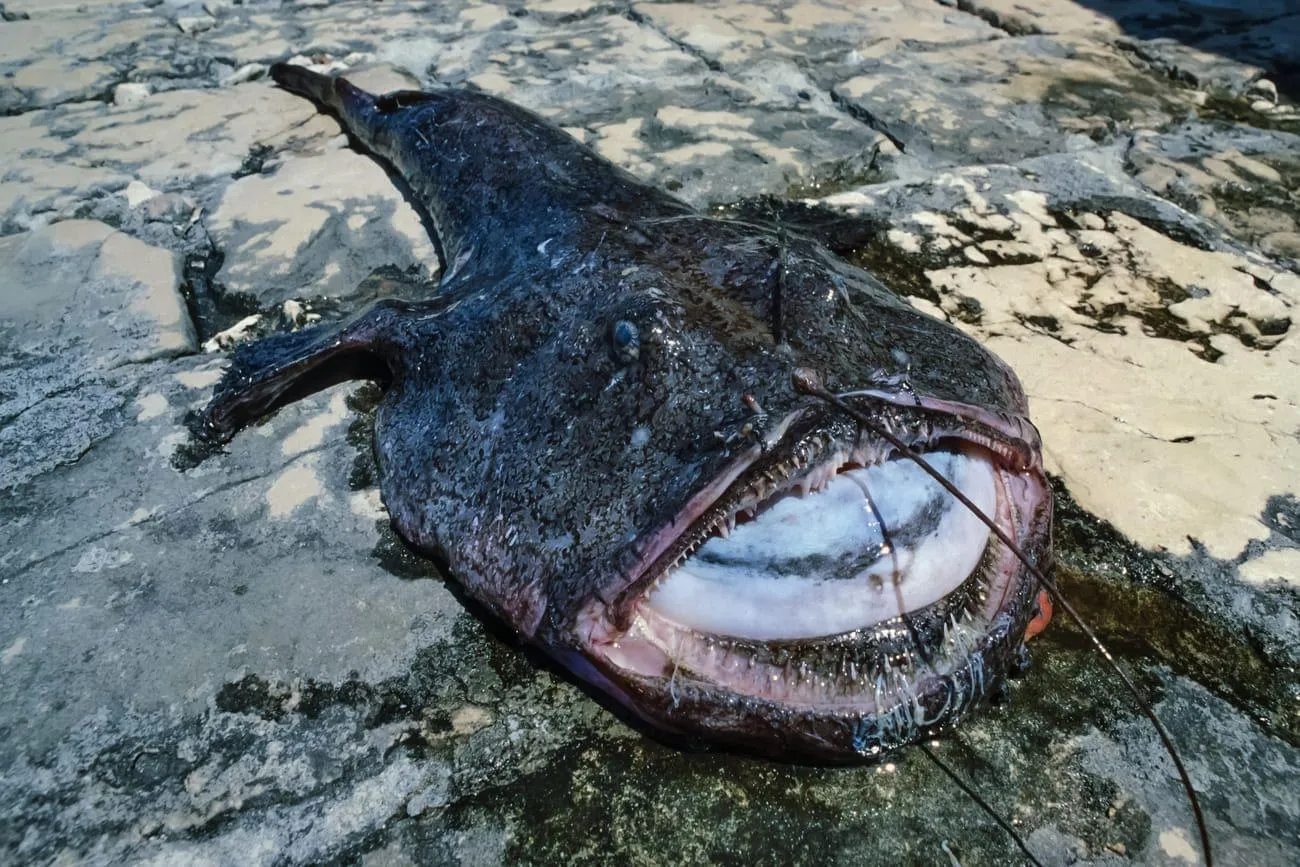
The appearance of the monkfish is very frightening. By the way, the length of his body can reach 20 m! Also, this fish has a fishing rod in the middle of its head, which helps to catch prey. When the monkfish is hungry, the fishing rod lights up, luring prey. Predator independently adjusts the glow.
The devil fish, as a rule, lies and waits for its prey. After that, the monkfish immediately opens its huge mouth and swallows the prey. When the monkfish is hungry, it can catch very large prey. Fortunately, monkfish do not pose a danger to humans.
20. Horizontal waterfall
This natural wonder is located in Talbot Bay in the Kimberley region of Western Australia. This natural phenomenon consists of two gorges in the McLarty Range, through which tidal waves push a huge amount of water, creating a temporary waterfall up to 5 meters high.
When the direction of the flow changes, the waterfall appears on the other side of the ridges. During high tides, water accumulates at the front of the faults faster than it can pass through them. This, in turn, creates the amazing effect of a waterfall, where the water is directed through a narrow opening and falls to a lower water level on the other side of the ridge.
21. Cocoon trees
In the Pakistani province of Sindh, after the most destructive flood in 80 years, in 2010 the invasion of spiders on trees began. As a result, the crowns of trees, tightened by thick webs, became like giant cocoons. This effect is explained by the fact that the spiders were forced to stay on the trees for a long period until the water recedes. To date, such a phenomenon has never been observed before. Surprisingly, this had a positive effect as it reduced the incidence of malaria. This is all because the spiders destroy the malaria mosquitoes that carry the deadly disease.
22. Stonehenge
 Stonehenge is one of the most famous sights in Great Britain, which is a grandiose archaeological site of the Neolithic era. This ancient megalithic structure was built between 3000 and 1500 BC. and is included in the UNESCO World Heritage List. The mysterious Stonehenge consists of huge stone blocks called menhirs or megaliths. The exact purpose of the ego is still unknown. Although archaeologists tend to conclude that Stonehenge is either an ancient cemetery or a construction of ancient astronomers for predicting cosmic phenomena.
Stonehenge is one of the most famous sights in Great Britain, which is a grandiose archaeological site of the Neolithic era. This ancient megalithic structure was built between 3000 and 1500 BC. and is included in the UNESCO World Heritage List. The mysterious Stonehenge consists of huge stone blocks called menhirs or megaliths. The exact purpose of the ego is still unknown. Although archaeologists tend to conclude that Stonehenge is either an ancient cemetery or a construction of ancient astronomers for predicting cosmic phenomena.
23. Multicolored hot lake
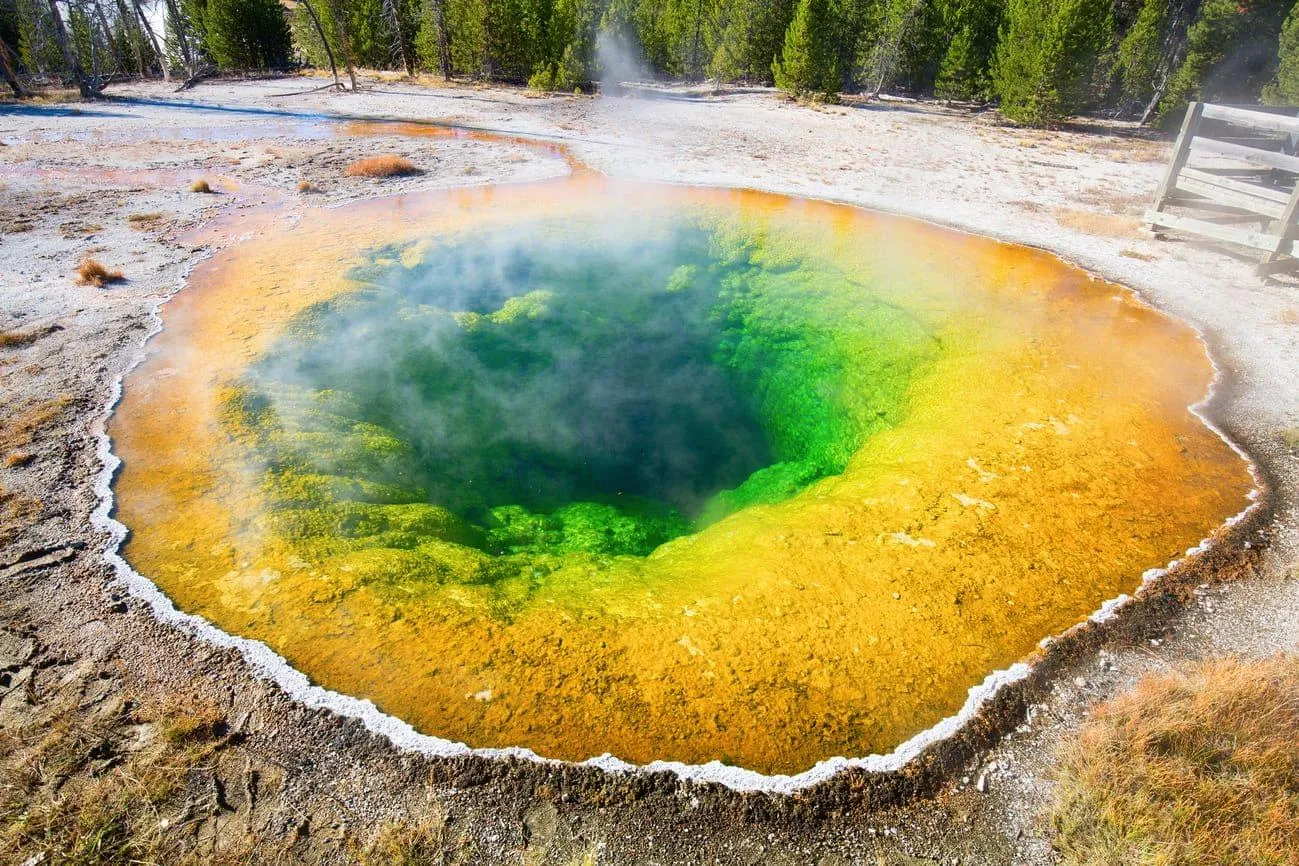 The huge prismatic hot spring located in Yellowstone National Park is the largest in America and the third largest in the world. Its size is 75 m by 91 m, the depth is 49 m, the volume of released water is about 2000 l / min at a temperature of 71 ° C. The characteristic color of the spring from green to brilliant red and orange colors is due to the presence of seaweed and coloring bacteria that live along the edge of the water surface enriched with minerals. An interesting fact is that the center of the reservoir is completely sterile due to extremely high temperatures.
The huge prismatic hot spring located in Yellowstone National Park is the largest in America and the third largest in the world. Its size is 75 m by 91 m, the depth is 49 m, the volume of released water is about 2000 l / min at a temperature of 71 ° C. The characteristic color of the spring from green to brilliant red and orange colors is due to the presence of seaweed and coloring bacteria that live along the edge of the water surface enriched with minerals. An interesting fact is that the center of the reservoir is completely sterile due to extremely high temperatures.
24. Tunnel of love
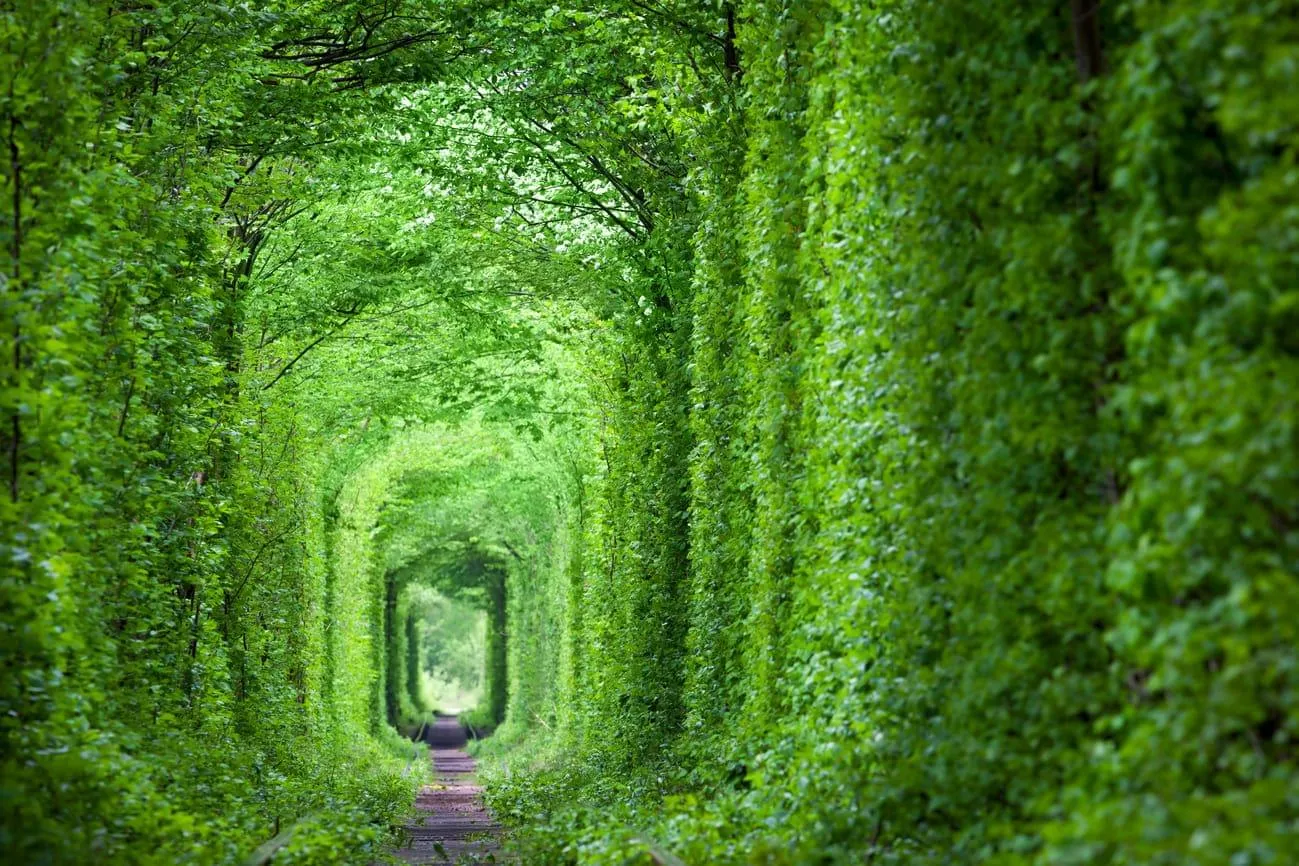 This 5-kilometer green corridor, which is made of trees that represent an arch of a perfect round shape, is located in Ukraine. It is best to visit this place in spring or summer when the trees are green. A whimsical play of light and shadow is observed in the tunnel, a kind of natural effect for photos. One of the most romantic places on the planet was opened very recently. More than 10 years ago, tourists accidentally came across a railway track that was hidden among the trees. The photo they took got into the Facebook social network and immediately became popular. Lovers believe that a kiss in the tunnel will seal their love for life.
This 5-kilometer green corridor, which is made of trees that represent an arch of a perfect round shape, is located in Ukraine. It is best to visit this place in spring or summer when the trees are green. A whimsical play of light and shadow is observed in the tunnel, a kind of natural effect for photos. One of the most romantic places on the planet was opened very recently. More than 10 years ago, tourists accidentally came across a railway track that was hidden among the trees. The photo they took got into the Facebook social network and immediately became popular. Lovers believe that a kiss in the tunnel will seal their love for life.
25. River of five colors
 This river, called Caño Cristales, is located in Colombia. It is called multi-colored for a reason, because it has many flowers that, thanks to the current, shimmer and intertwine, forming ever new unusual colors. All this beauty in the Caño Cristales River is formed due to the unusual algae that grow in it. They are called Macarenia clavigera. This vegetation regularly changes color, following the season, weather and even air temperature. Algae can be compared to a chameleon that changes its color to suit its environment.
This river, called Caño Cristales, is located in Colombia. It is called multi-colored for a reason, because it has many flowers that, thanks to the current, shimmer and intertwine, forming ever new unusual colors. All this beauty in the Caño Cristales River is formed due to the unusual algae that grow in it. They are called Macarenia clavigera. This vegetation regularly changes color, following the season, weather and even air temperature. Algae can be compared to a chameleon that changes its color to suit its environment.
26. Quokka
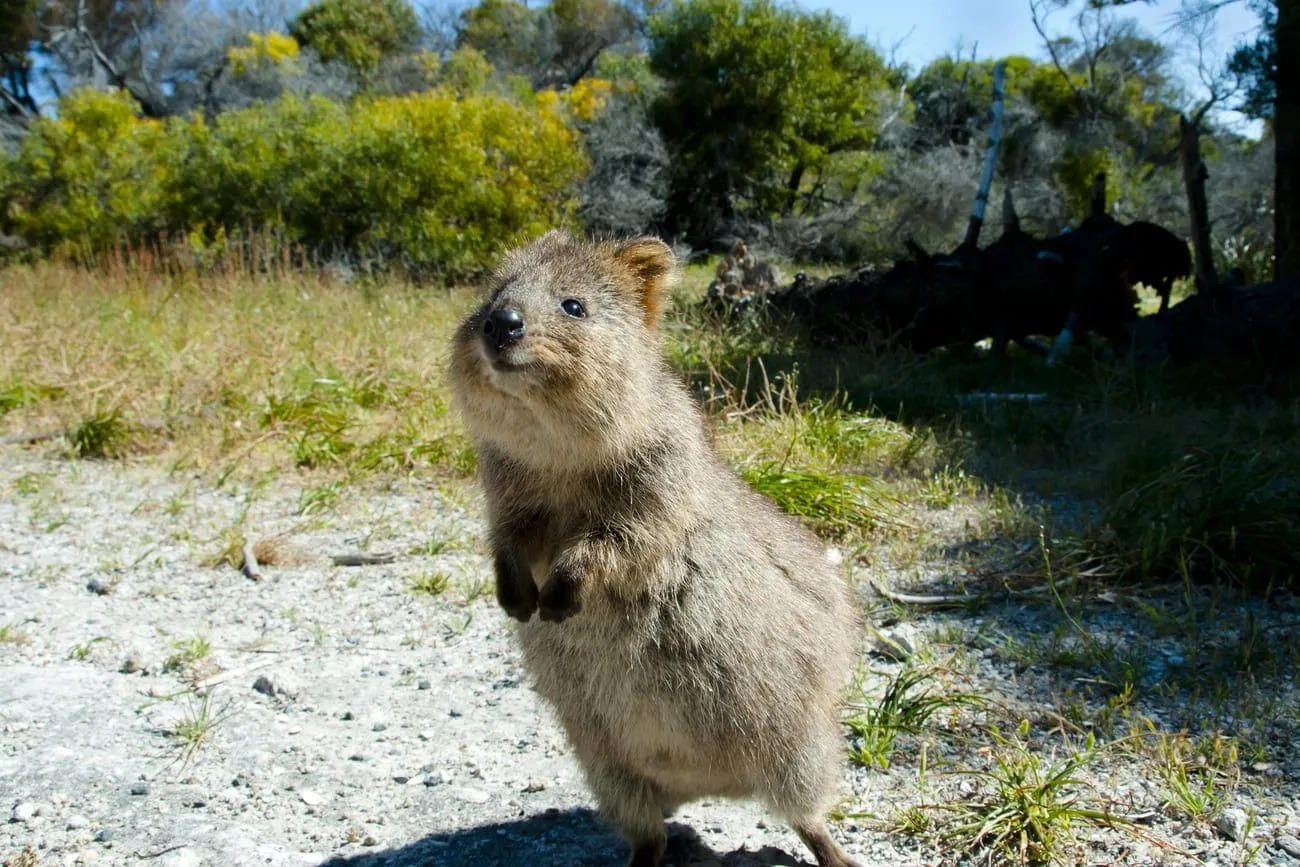 The quokka is a relative of the kangaroo, but much smaller in size. This unusual animal lives in the tropical forests of Australia and on Bland and Rottnest islands, it is active mainly at night. Distinguishing features - beautiful, thick fur, gray on the head and red on the neck. Unfortunately, poachers also liked the quokka's fur, which is why the animals are an endangered species.
The quokka is a relative of the kangaroo, but much smaller in size. This unusual animal lives in the tropical forests of Australia and on Bland and Rottnest islands, it is active mainly at night. Distinguishing features - beautiful, thick fur, gray on the head and red on the neck. Unfortunately, poachers also liked the quokka's fur, which is why the animals are an endangered species.
Interestingly, in 1696 the Dutch who came to Bland and Rottnest islands thought that the quokkas were big rats and called the island the Rat's Nest.
27. Antelope Canyon, Arizona
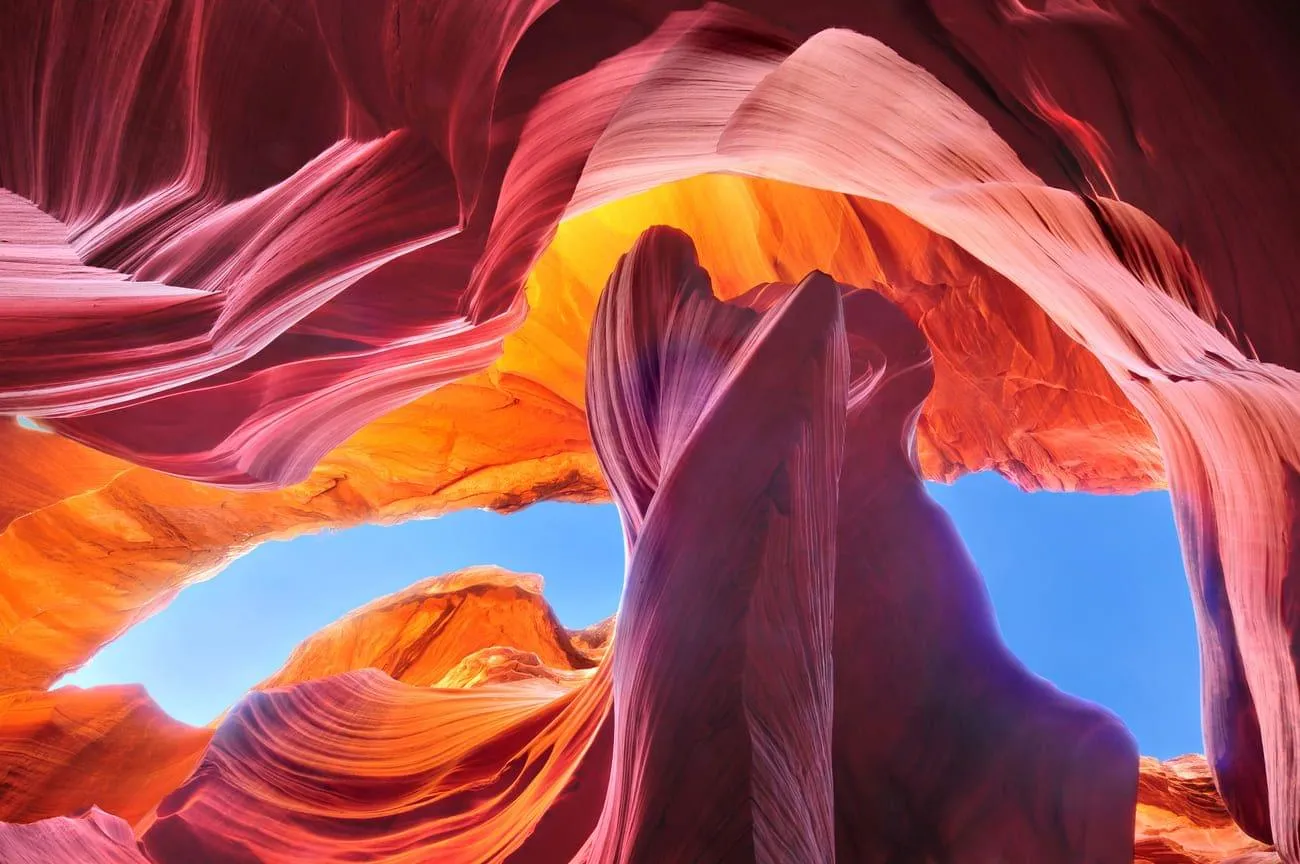 This real miracle is sand rocks, in which millions of years of water and wind have carved bizarre cracks several tens of meters deep, painted in reddish-red tones. It is thanks to this color combination, reminiscent of the skin of an antelope, that the canyon got its name. This miracle is located in the southwest of the USA, in the state of Arizona. A large coal-fired power plant serves as a unique landmark. This land belongs to the Navajo Indians. In fact, there are two Antelope canyons - Upper and Lower. According to legend, they were accidentally discovered by a little Indian woman who was looking for a stray goat here.
This real miracle is sand rocks, in which millions of years of water and wind have carved bizarre cracks several tens of meters deep, painted in reddish-red tones. It is thanks to this color combination, reminiscent of the skin of an antelope, that the canyon got its name. This miracle is located in the southwest of the USA, in the state of Arizona. A large coal-fired power plant serves as a unique landmark. This land belongs to the Navajo Indians. In fact, there are two Antelope canyons - Upper and Lower. According to legend, they were accidentally discovered by a little Indian woman who was looking for a stray goat here.
28. Moeraki stone balls
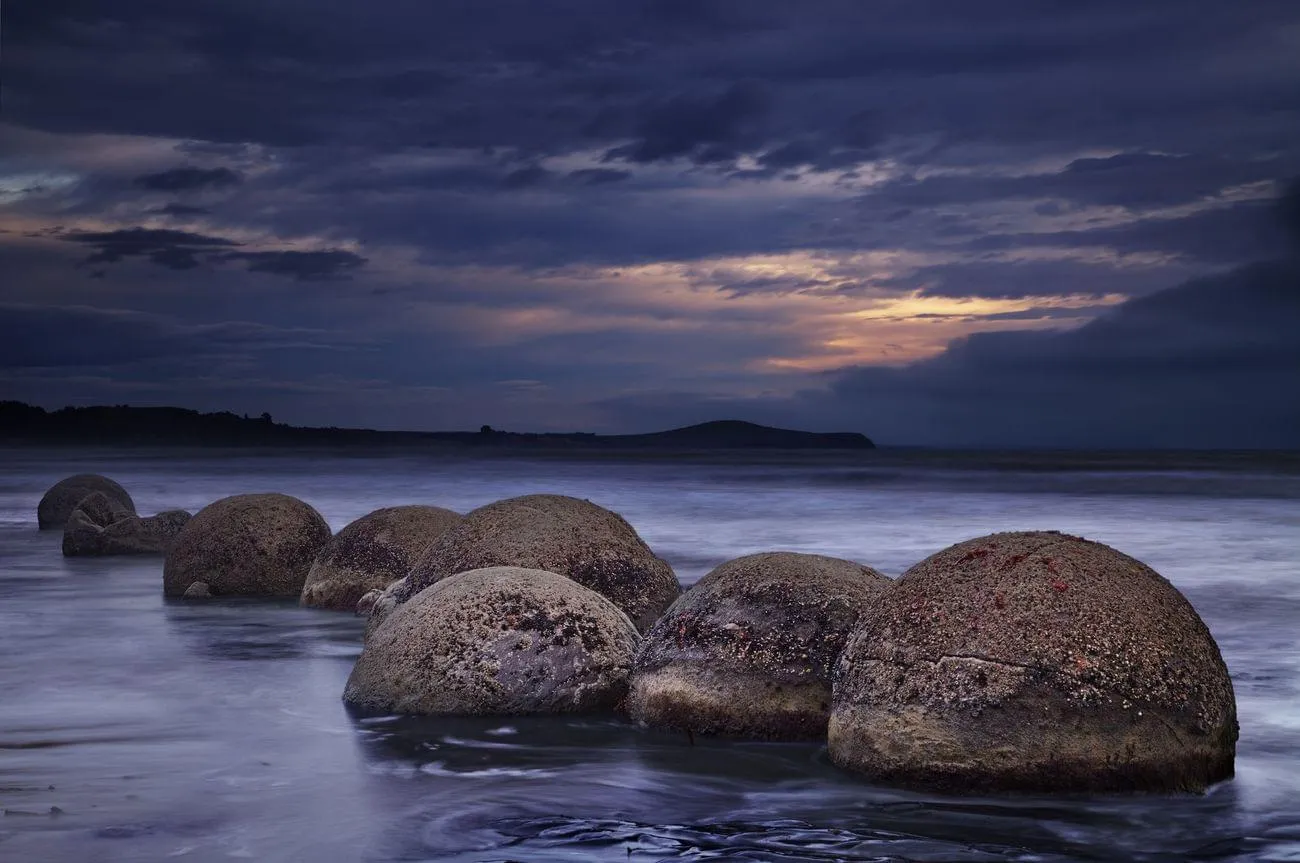 This mysterious natural wonder is located on the 300-meter Koehohe Beach in New Zealand. There are several hundreds of stone layers here. Some of them are on the beach, some are in the water, some are broken into pieces. Diameter - 0.5-2.2 meters. They were formed during the Paleocene - 65-56 million years ago! Scientists studied these round stones and came to the conclusion that they consist of sand, silt and clay cemented with calcite. But how they appeared is unknown.
This mysterious natural wonder is located on the 300-meter Koehohe Beach in New Zealand. There are several hundreds of stone layers here. Some of them are on the beach, some are in the water, some are broken into pieces. Diameter - 0.5-2.2 meters. They were formed during the Paleocene - 65-56 million years ago! Scientists studied these round stones and came to the conclusion that they consist of sand, silt and clay cemented with calcite. But how they appeared is unknown.
29. Urulu rock
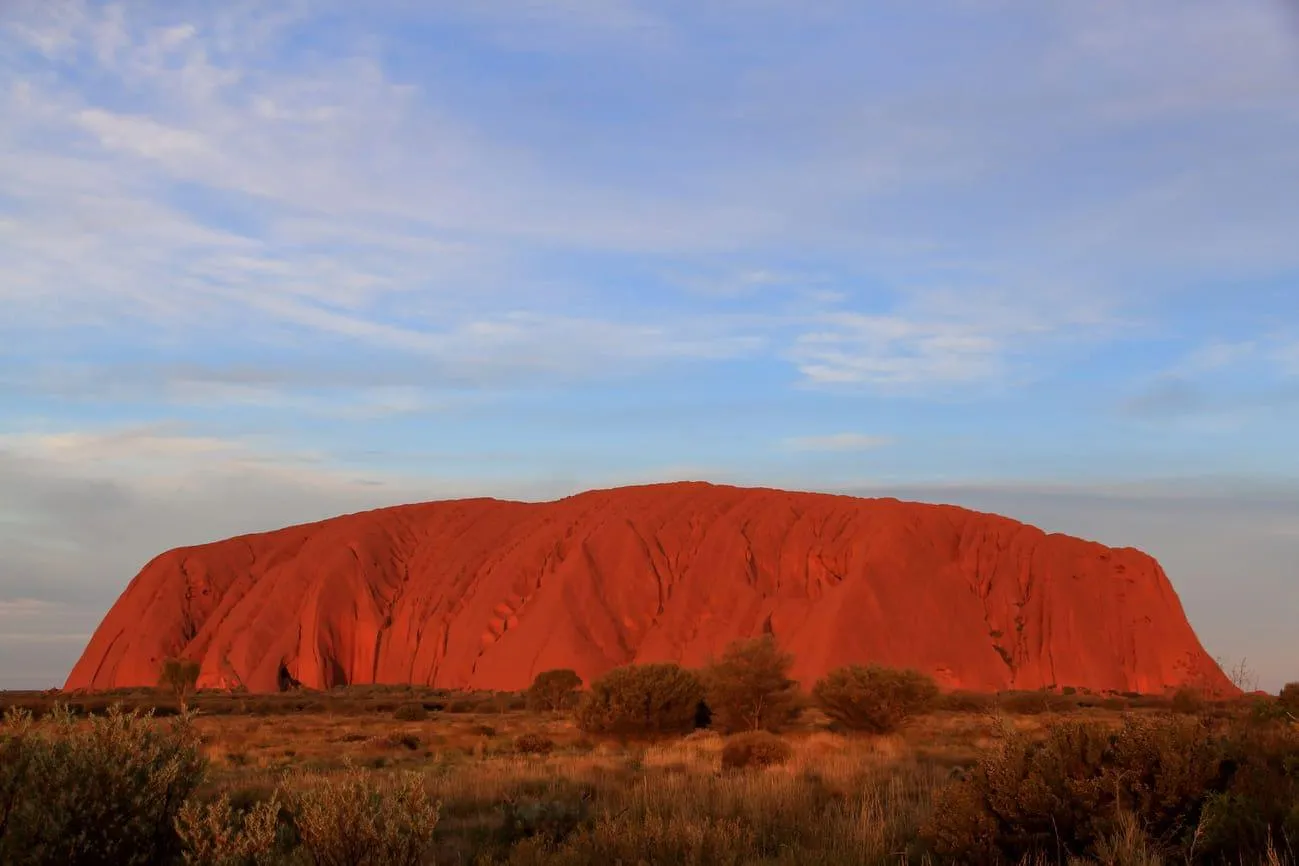 The mysterious rock of Uluru, which is located in Australia, became famous due to its bright orange color and unusual oval shape. It was formed 680 million years ago and is located in the desert. It is interesting that the rock can change color depending on the time of day - from orange to red. There are several caves in it, during the study of which scientists found fragments of ancient rock paintings.
The mysterious rock of Uluru, which is located in Australia, became famous due to its bright orange color and unusual oval shape. It was formed 680 million years ago and is located in the desert. It is interesting that the rock can change color depending on the time of day - from orange to red. There are several caves in it, during the study of which scientists found fragments of ancient rock paintings.
30. Transparent butterfly
 In the forests of South America, there are unique butterflies from the Nymphalidae family, which is found in the forests of the Amazon basin. This small insect with a wingspan of only 5-6 centimeters. But this is a transparent butterfly - it has a transparent fabric between the veins on its wings. There are simply no colored scales.
In the forests of South America, there are unique butterflies from the Nymphalidae family, which is found in the forests of the Amazon basin. This small insect with a wingspan of only 5-6 centimeters. But this is a transparent butterfly - it has a transparent fabric between the veins on its wings. There are simply no colored scales.